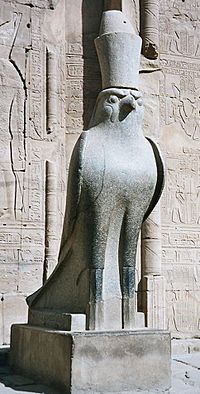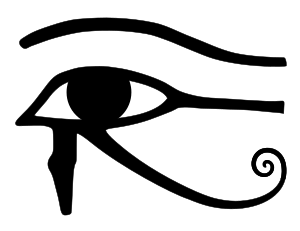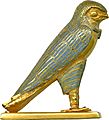Horus facts for kids
Horus was the Egyptian god of the Sky. He was the son of Isis and Osiris. After fighting his uncle, Set (Osiris and Isis' brother) he became the king of Egypt. During this fight, he lost his eye. The Eye of Horus became one of the most important symbols in ancient Egypt and Egyptian civilization. When Horus lost his eye, his eye set out on a journey of its own. When the other Gods tried to catch the eye, his eye began to cry. These tears became the first people of Egypt in Egyptian belief.
The Eye of Horus
The Eye of Horus, also known as wadjet eye, wedjat eye or udjat eye, is an ancient Egyptian symbol of protection, royal power, and good health. The Eye of Horus is similar to the Eye of Ra, which belongs to a different god, Ra, but represents many of the same concepts. According to Egyptian myth, Horus lost his left eye in a struggle with Seth. The eye was magically restored by Hathor, and this restoration came to symbolize the process of making whole and healing. For this reason, the symbol was often used in amulets.
Worship
Horus, was worshiped all over Egypt, especially in Pe, Bendet and Khem. There were many falcon gods before Horus, but eventually Horus represented all of them. He was worshiped until the end of the Pre-Dynastic period. In Upper Egypt (south), in the town of Edfu, was Ptolemaic, a temple for Horus. In Kom Ombo, there was another temple for Horus called the Kom Ombo temple. Horus was a good friend of Sobek. He was also worshipped as a guide to the pharaohs.
Physical appearance
Horus was considered handsome and usually appeared as a falcon or a falcon headed man, although sometimes he appeared as a falcon headed crocodile. Sometimes he would take the form of a celestial falcon with his left eye the moon and his right eye the sun, his speckled breast feathers the stars, the down sweep of his wings creating the winds. He is sometimes shown with a copper knife. In addition, he normally wore the double crown to signify his rule over all of Egypt and to relate with the Pharaoh.
Purpose
Horus was the god of the sky and also the God of war. The pharaoh ruling at any given time of Egypt was always the living image of Horus. When he died, that pharaoh became Osiris, the god of the dead and the father of Horus. The new pharaoh became Horus. His purpose was to protect the pharaoh. He was a protector god, who was a god who fought evil. He represented justice and righteousness. He fought with Seth to avenge his father, Osiris, who was killed by Seth. When Horus defeated Seth, he conquered his father, Osiris', throne, and became protector.
Images for kids
-
Horus, Louvre, Shen rings in his grasp
-
Horus falcon, after 600 BCE. Original in the Department of Ancient Egypt and Sudan, British Museum
-
Her-iunmutef (Iunmutef), ('Horus, Pillar of His Mother'), depicted as a priest wearing a leopard-skin over torso in the Tomb of Nefertari, Valley of the Queens
-
Herui, the 5th nome god of Upper Egypt in Coptos besides the pharaoh Sahure
-
Horus, patron deity of Hierakonpolis (near Edfu), the predynastic capital of Upper Egypt. Its head was executed by means of beating the gold then connecting it with the copper body. A uraeus is fixed to the diadem which supports two tall openwork feathers. The eyes are inlaid with obsidian. Sixth Dynasty.
-
Horus represented in relief with Wadjet and wearing the double crown. Mortuary Temple of Hatshepsut
-
Horus relief in the Temple of Edfu
-
Statue of Horus in the Temple of Edfu
-
Statue of Horus from the reign of Amenhotep II (Eighteenth Dynasty, ca. 1400 BCE) in the Musée royal de Mariemont, Belgium
See also
 In Spanish: Horus para niños
In Spanish: Horus para niños


















